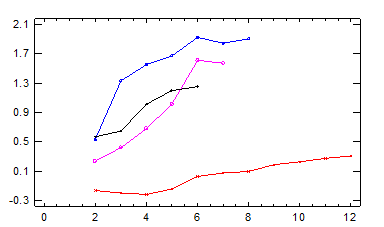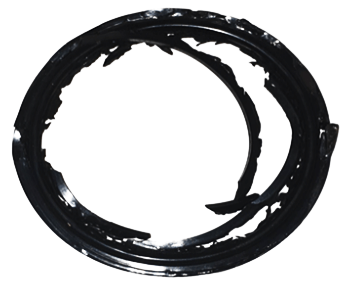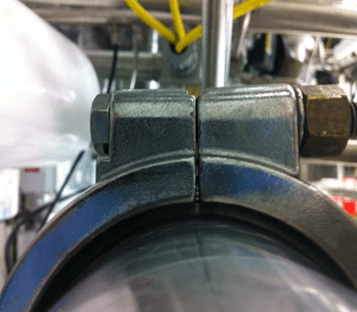You are currently viewing the James Walker Global website.
You are currently viewing the James Walker Global website.

The use of too high an applied load is a common mistake in forming a sealing joint.
Thursday, February 10, 2022The use of too high an applied load is a common mistake in forming a sealing joint; higher loads are not better and can be detrimental, causing damage to the ferrules, fasteners and the seal, thus compromising sealing integrity. Additionally, too high an applied load results in excessive intrusion, which in turn can result in reduced flow, difficulty in cleaning and the possibility of seal sections breaking off and entering the process flow.
For example, the graph below shows the effect of torque on intrusion for four different manufacturers, including James Walker's Elast-O-Pure® EP75B material, over a wide torque range for the 1” gaskets.

ASME BPE 2019 defines intrusion limits in two categories: category I of ± 0.6 mm, and category II of ± 0.2 mm. From the graph bottom left, we can see the James Walker product (indicated by the red line) satisfies category I at all applied torque, even at excessive tightening, and category II at the recommended torque of 5 Nm for Elast-O-Pure EP75B. For competitor gaskets the intrusion rises sharply, and at useful sealing torque values they all fail to comply with intrusion requirements, even category I.
Investigating intrusion further, a bank of ten 1” gaskets (including both James Walker product and that of a competitor) were torqued to 5 Nm and subjected to 100 clean steam cycles at 125oC. The average intrusion for the James Walker gasket was 0.00 mm, whereas the competitor gasket gave an average intrusion of 1.21 mm (see picture top right). Such high levels of intrusion resulted in a 20% reduction in cross sectional area, reducing flow rates and introducing the possibility of the protruding seal sections breaking off and entering the process flow, as well as making cleaning in place more problematic. Additionally, for the competitor gaskets the fasteners had become loose, due to thinning of the gasket caused by material movement, raising the possibility of a leak.
 A further consequence of over tightening is damage to the seal and fittings. The picture on the right shows damage around the entire seal and is a direct consequence of applying too much force on the seal by over torqueing.
A further consequence of over tightening is damage to the seal and fittings. The picture on the right shows damage around the entire seal and is a direct consequence of applying too much force on the seal by over torqueing.
A particularly worrying aspect of over torqueing is shown below. Note the metal-to-metal contact on the clamp, which again does not comply with guidelines laid out in ASME BPE 2019. In this particular high pressure clamp arrangement with two bolt fasteners, one fastener is overtightened, therefore the other fastener may not be tight enough, giving lower sealing forces in the vicinity, and therefore creating a potential leak path.
 As the picture on the left shows, the bolt is now bent and will need replacing. Additionally, at such loads it is likely the ferrule will be damaged, and may also need to be replaced.
As the picture on the left shows, the bolt is now bent and will need replacing. Additionally, at such loads it is likely the ferrule will be damaged, and may also need to be replaced.
The correct applied torque depends on many factors, primarily the clamp type and the seal material mechanical properties. Consequently the seal suppliers recommended torque levels must be followed. Clamps vary greatly in design; single or double hinged, one or two fasteners, all of which have an effect on the load experienced by the seal.
The question remains how do we prevent the ‘natural’ tendency to overtighten in the belief that this gives a better sealed joint.
Education and training play a large part in this and the seal manufacturer should supply guidelines and/or training on how to fit their seals, particularly the applied torque for a given joint to give good sealing and minimal intrusion.
However, even with training, there is still the possibility of incorrect installation and mechanical methods are required to eliminate the possibility of any human error. Two possible options are available:
1. Calibrated torque wrench. Use of a calibrated torque wrench can eliminate over tightening provided these are used properly. There are torque wrenches available fitted with a universal socket suitable for all wing nut designs, and other more standard wrenches for the fastener nuts. These will slip, or click, when the appropriate torque is reached. The most reliable wrenches have a fixed torque, not variable, to give more consistent fitting.
2. Controlled torque clamp fittings. A more advanced engineering option, and arguably more reliable, with greater torque control, is a controlled torque mechanism incorporated into the clamp design. Such designs simply do not allow over tightening, eliminating any human factors in fitting the seal.
Naturally, for both systems the torque setting must reflect the seal manufacturers recommended torque level, with calibration of each system required on a regular basis.


Want to discuss your project, engineering or materials challenge expert to expert? Simply provide us with your contact details and a little information about the application you are working on, and one of our experts will contact you as soon as possible.